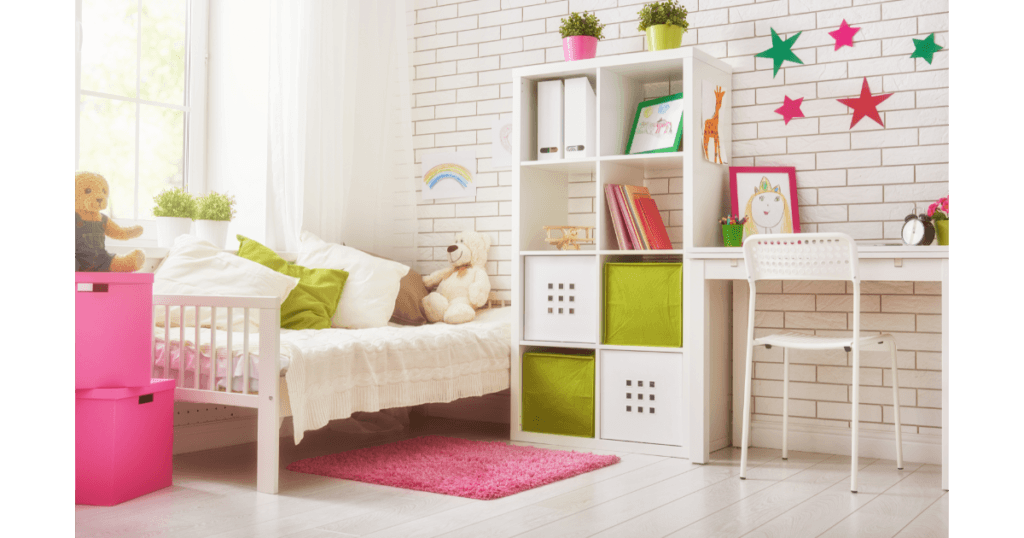It’s the time of year when kids are mentally ready to accept a fresh start as the new school year gets underway. So what better time than to embrace this fresh start mentality at home by decluttering their rooms? Concentrating on these areas are a great place to start for an end of summer reckoning or anytime you feel like they need a little reset.
Step One – Declutter
We’re going to be straight with you. This activity takes strong will power. It’s easy to look at the hot mess and tell yourself some stuff has to go but when you start weaving your way through the aftermath of the wrecking ball, memories may resurface that tempt you to hang onto more stuff than you need.
Before you dive in to declutter, remind yourself that the goal is to simplify and give your kids a better space for playing and living. And if your child is helping with this exercise, assure him/her that letting go of some things is a win-win. It means another child gets something “new” to use and your child makes space for cool, new things.
Tackle-n-Toss Checklist
- Broken Stuff: An easy way to start is clearing away anything that is broken. The action figure that’s missing an arm. The dress-up outfit that the dog chewed a huge hole in. Crayon stubs that no one can hold. Clear all these damaged items and enjoy the breathing room.
- Misfit Toys: Every kid’s room has a unique collection of these. All those small plastic toys from happy meals, birthday parties, grab bags – you get the idea. If it hasn’t found a place of honor in your kid’s play rotation yet, toss or donate it.
- Thin Out Books: Like little bodies outgrow clothes, big minds and imaginations outgrow books. If your bookworm’s shelves are overflowing, it’s time to save a few sentimental titles and donate the rest. Make room for new titles that encourage your youngster to advance their reading skills.
- Paper Palooza: Kids win prizes for paper collections. Art projects of yesteryear? Notebooks tossed under the bed? Partially used coloring books? And those Valentines cards from every classmate? Thumb through for anything indicative of early artistic genius that you want to display or put in a sentimental box. Then recycle the rest.
- Baby Items: Do you still have baby blankets in the closet? How about an activity gym or monitor? If you’re like me, guilty as charged. Your child is no longer using these items so it’s time they vacated his/her bedroom. If you’re done adding to your family, it may be time to pass these on or donate to those in need.
- Outgrown Clothes and Shoes: Kids outgrow wardrobes faster than a wink of an eye. Before we know it, the pants are too short and their toes are curling up in shoes. Take honest stock of what your kid wears, and purge what’s too small, stained, or simply not your kid’s style.
- Random Socks: Every house has a sock fairy. Somehow, some way socks just disappear into thin air. Relocate all random socks to a bin in the laundry room. After a week with no match, accept the fact that the sock fairy wins and toss the solo sock.
- Arts and Crafts: Oh how these multiply and accumulate from different kits! Do you really need six glue sticks and some random pipe cleaners? Organize craft supplies in clear bins with picture labels. Toss out anything broken, dried out (or extremely messy). Donate excess supplies to a school or church.
- Stuffed Animals/Dolls: Baby dolls and stuffed animals seem to magically reproduce in kids rooms when nobody’s looking. And kids easily grow attached to these. No matter what age your child is, this will likely be a battle. If your little collector is old enough to rise to the task without inflicting separation anxiety, then work together to sort them into two piles – keep and donate. You may need to start with just a couple. But if your child can handle it, try to decrease the keep lot to fifty percent.
Step 2 – Keeping It Clean
Now that most of the hard work is over, commit to a regular clean-up process so the large-scale declutter task isn’t so daunting in the future.
1. Don’t micromanage the small stuff.
Toys and parts often migrate throughout the house and end up right on your last nerve. While these LEGOs and squishies may be tiny, they could benefit from a mobile home. Rather than spend time every day ushering them back to individual containers, consider arming your child with one big bag or bin that he/she can move about the house with, such as the Swoop Bag. Once a day, it’s your child’s responsibility to collect all the little things into this designated on-the-go bag.
2. Designate a donation bin.
Establish an ongoing habit of decluttering by keeping a small donation box in the closet for collecting outgrown clothes. As soon as it no longer fits, toss it in and once the box is full, donate it.
3. Treasure the sentimental stuff.
Parents, we are one of the biggest reasons it’s so hard to clear out what our kids have outgrown. It pulls at our emotions! Afterall, that was her first day of preschool outfit or the toy dog sidekick that he took everywhere for years. Designate one or two bins to keep the sentimental stuff. Or better yet, hang up a shadow box or shelf to showcase these items and keep the memories alive in your home.
4. Use the “out of sight, out of mind” method.
Once a month, do a quick sweep and stash toys that haven’t been played with in a while. Set a time limit for hiding these. If no one has asked for it within the time limit, then you can get rid of it. This is a great practice for us parents to adopt with our belongings, too.
5. Don’t go hog wild on storage solutions.
It’s a little counterintuitive, but it has merit. We are all for stylish, sensible ways to organize but if you add containers, then the kid is going to fill them up. Work with what you have to minimize excess and keep it simple – the answer isn’t always to store it.
6. Motivate kids to keep the room clean.
There’s lots of ways to make cleaning fun. Put on some upbeat music and have a dance battle while picking up toys. Make a game of basketball out of the laundry basket or trash can. Hide little prizes/easter eggs around a messy room that they can find while cleaning. If they experience joy from a clean, organized space then they will naturally help keep it that way.
Takeaway
Some kids will view decluttering as a negative because they feel like they are losing precious items. Have no fear – you can turn this negative into a positive by taking your children with you to donate the toys and clothes they helped clean out. Kids will experience feelings of joy and warmth when sharing their gently-used toys and stuffed animals with someplace like your local children’s hospital or a needy family.
Lastly, while we all dream of having tidy spaces to breathe easier in, it’s important to remember that these are kids’ spaces. So let (some) clutter go. It should look like a kid lives, plays, and imagines in these spaces, which means extra stuff is sometimes just part of the fun, messy wonder of it all. So relax, and remember that the next time you enter the disaster zone when clutter accumulates.
What do you struggle with the most in keeping kids’ rooms clean and tidy? Have something to share that might be helpful? Drop a note in the comments.


